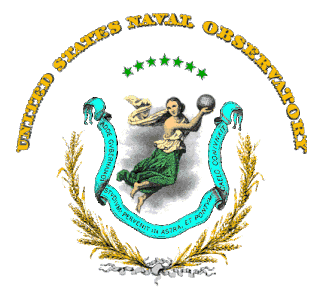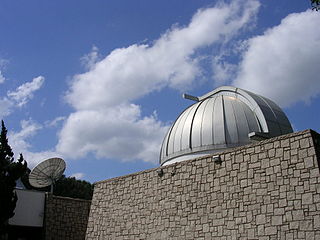
The United States Naval Observatory (USNO) is one of the oldest scientific agencies in the United States, with a primary mission to produce positioning, navigation and timing for the United States Navy and the United States Department of Defense.

An observatory is a location used for observing terrestrial, marine, or celestial events. Astronomy, climatology/meteorology, geophysical, oceanography and volcanology are examples of disciplines for which observatories have been constructed. Historically, observatories were as simple as containing an astronomical sextant or Stonehenge.

The Washburn Observatory is an astronomical observatory located at 1401 Observatory Drive on the University of Wisconsin–Madison campus in Madison, Wisconsin, United States. Completed in 1881, it was a major research facility for about 50 years. Today, it is home to the UW-Madison College of Letters and Science Honors Program, while the telescope remains in use by students in introductory astronomy courses and the general public during open houses and viewings.

The Pine Bluff Observatory (PBO) is an astronomical observatory located in the town of Cross Plains, Wisconsin (USA) about 24 kilometers (15 mi) west of Madison. PBO is owned and operated by the University of Wisconsin–Madison (UW-Madison). It opened in 1958, and is mainly used by students and faculty of UW-Madison for instruction and research. PBO also provides a facility for testing new instruments. Recent research conducted at PBO includes measuring the lunar sodium tail, monitoring circumstellar disks around Be stars, and studying the warm ionized medium.

The Apache Point Observatory is an astronomical observatory located in the Sacramento Mountains in Sunspot, New Mexico, United States, approximately 18 miles (29 km) south of Cloudcroft. The observatory is operated by New Mexico State University (NMSU) and owned by the Astrophysical Research Consortium (ARC). Access to the telescopes and buildings is private and restricted.

Laws Observatory is the name of three separate astronomical observatories owned and operated by University of Missouri from 1880 to the present. Named after former University President Samuel Laws, it is located in Columbia, Missouri (USA).

Hobbs Observatory is an astronomical observatory owned and operated by University of Wisconsin–Eau Claire's Department of Physics and Astronomy and home to the Chippewa Valley Astronomical Society. It is located in the Beaver Creek Reserve four miles North of Fall Creek, Wisconsin. It is named after the Hobbs Foundation, a local philanthropic organization which provided money for the initial construction in 1978 and the purchase of a Navy telescope.

Judson B. Coit Observatory is an astronomical observatory owned and operated by Boston University on the roof of the College of Arts & Sciences at 725 Commonwealth Avenue in Boston, Massachusetts, USA. The observatory is used in undergraduate and graduate courses of the Boston University Department of Astronomy, and for observing projects of the Boston University Astronomical Society.

Hard Labor Creek Observatory is an astronomical observatory owned and operated by Georgia State University in the United States. It is located within Hard Labor Creek State Park, 50 miles east of the Atlanta, Georgia campus.

Dr. Ralph L. Buice, Jr. Observatory is an astronomical observatory owned and operated by the Fernbank Science Center. It is located between Decatur and Atlanta, Georgia (USA). The observatory owns a 0.9144 m (36.00 in) Cassegrain telescope housed beneath a 10 m (33 ft) dome.

C.E.K. Mees Observatory is an astronomical observatory in Bristol, New York, owned and operated by the University of Rochester. The observatory is named after C. E. Kenneth Mees, "in honor of his pioneering work in the development of sensitive photographic emulsions for use in astronomy."

Cordell–Lorenz Observatory (850) is an astronomical observatory owned and operated by Sewanee:The University of the South. It is located in Sewanee, Tennessee, United States.

Anderson Mesa Station is an astronomical observatory established in 1959 as a dark-sky observing site for Lowell Observatory. It is located at Anderson Mesa in Coconino County, Arizona (USA), about 12 miles southeast of Lowell's main campus on Mars Hill in Flagstaff, Arizona.

Gemini (♊︎) is the third astrological sign in the zodiac, originating from the constellation of Gemini. Under the tropical zodiac, the sun transits this sign between about May 21 to June 21. Under the sidereal zodiac, the sun transits this sign from about June 16 to July 16. Gemini is represented by the twins, Castor and Pollux, known as the Dioscuri in Greek mythology. It is a positive, mutable sign. Gemini is associated with the Yang polarity (masculine) in the Yin Yang ancient Chinese concept.
The NRAO VLA Sky Survey (NVSS) was an astronomical survey of the Northern Hemisphere carried out by the Very Large Array (VLA) of the National Radio Astronomy Observatory (NRAO), resulting in an astronomical catalogue. It was led by James J. Condon.

Airdrie Public Observatory is a fully operational, historic astronomical observatory, which is part of the library building in the town of Airdrie, North Lanarkshire, Scotland. There are only four public observatories operating in the United Kingdom, all of which are in Scotland. Airdrie Observatory is the smallest, and second oldest.

Fuertes Observatory is an astronomical observatory located on the North Campus of Cornell University in Ithaca, New York. The observatory was designed by L.P. Burnham, Cornell Professor of Architecture and completed in fall of 1917. It was originally used by the Civil Engineering Department as an instructional field office for navigation and surveying. Today, the observatory is primarily used for public outreach, welcoming over two thousand visitors per year with open houses on clear Friday nights.

A total solar eclipse occurred on May 28, 1900. A solar eclipse occurs when the Moon passes between Earth and the Sun, thereby totally or partly obscuring the image of the Sun for a viewer on Earth. A total solar eclipse occurs when the Moon's apparent diameter is larger than the Sun's, blocking all direct sunlight, turning day into darkness. Totality occurs in a narrow path across Earth's surface, with the partial solar eclipse visible over a surrounding region thousands of kilometres wide.

The Portage Lake Observatory (PLO) was an astronomical observatory owned and operated by the University of Michigan (UM). It was located near the village of Dexter, Michigan (USA), about 20 kilometers (12 mi) northwest of Ann Arbor. Construction at the site began in 1948, and the facility was closed in 1975.

Blue Mesa Observatory (BMO), also referred to Magdalena Peak Station for the International Planetary Patrol Program, was an astronomical observatory owned and operated by New Mexico State University (NMSU). It was located on Magdalena Peak in the Sierra de las Uvas of southern New Mexico (US), approximately 43 kilometers (27 mi) northwest of Las Cruces. Founded in 1967 under the supervision of Clyde Tombaugh, the observatory was closed in 1993. The site and the 30 acres surrounding it were conveyed to the Federal Aviation Administration, which tore down the observatory building and replaced it with a radar installation.










